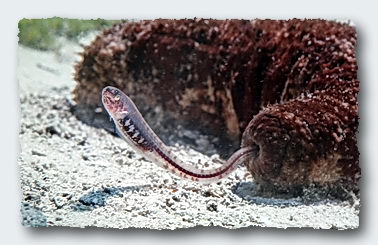
Carapus bermudensis
FAMILY
Carapidae
TAXONOMY
Lefroyia bermundensis Jones, 1874, Bermuda. The holotype was
named in honor of Lefroy, a former governor of Bermuda.
The species is now valid as Carapus bermudensis (Jones) following
several taxonomic revisions. Numerous names are probably
referable to C. bermudensis, including C. recifensis, C. chavesi,
and Fierasfer dubius. C. bermudensis may be related most closely
to C. acus, its eastern Atlantic relative. The species-level relationships
of the genus, however, are poorly known.
OTHER COMMON NAMES
None known.
PHYSICAL CHARACTERISTICS
Carapus bermudensis is long, slender, and eel-like, with a large
head and relatively large eyes. It is translucent, with silvery
bands along the flanks, black internal pigment visible along the
vertebral column, a silver cheek patch, and large pigment
blotches along the bases of the dorsal and anal fins and head.
The anal fin origin is anterior to the dorsal fin origin. There are
13–18 anal rays anterior to the first dorsal ray. This number
varies among pearlfish species and is useful in identification.
There are no pelvic fins, and the caudal fin usually is absent.
The pectoral fin has 17–20 rays. The teeth on the upper jaw are
small, and some are heart-shaped. The teeth on the lower jaw
are larger and conical. The air bladder is separated into two
parts by an internal constriction under vertebrae 11 and 12. This
feature of the internal anatomy is characteristic of all species in
the genus Carapus, and the position of the constriction relative
to the vertebrae allows for separation of species.
DISTRIBUTION
Distributed in shallow waters along the shores of the western
Atlantic, Bermuda, and the Caribbean Sea south to Brazil. Its
larvae sometimes are collected far north and east of this range
in plankton samples taken by research cruises.
HABITAT
All species of the genus Carapus have obligatory commensal relationships
with sea cucumbers (Holothuria), starfishes (Asterioidea),
or sea squirts (Ascidiacea). Many species exhibit host
specificity. Carapus bermudensis has been collected in the body
cavity of nine holothurian species in the genera Actinopyga, Isostichopus,
Thone, Astichopus, Holothuria, and Theelothuria. These
host species generally reside in shallow waters, to about 98.4 ft
(30 m) on sandy bottoms or grass beds in tropical and subtropical
lagoons near reefs. In one study in the Bahamas, pearlfishes
were found in relatively few restricted areas, although
more than 1,000 sea cucumbers were surveyed.
BEHAVIOR
Resides within the body of its host during daylight and is believed
to exit at night to forage and perhaps spawn. This strategy
limits the probability of predation by larger fishes. This
species has been observed in aquaria as it rapidly enters its primary
host, Actinopyga agassizi. The species first locates the anal
opening of the sea cucumber with its snout, presumably
through olfaction. As the fish holds its head in the proper position
at the anal opening, the body curves and the tip of the tail
tracks along the mid-lateral line until it reaches the anus. Once
the tail tip is aligned and pointed into the opening, the fish
abruptly turns, forcing its way tail first into the host by body
undulations. There are no observations of living pearlfishes in
the wild and little data on its habits and
BEHAVIOR
s.
FEEDING ECOLOGY AND DIET
Some inquiline pearlfishes are parasitic, dining on the internal
organs of the invertebrates they occupy. This species of pearlfish
is not parasitic and feeds outside the holothurian host,
probably at night. There have been no detailed studies of the
food habits of this species, but gut contents of individuals are
mostly crustacean invertebrates, such as amphipods, small
shrimps, crabs, and mysids. Rarely, a pearlfish is found in the
stomach of larger, predaceous fishes.
REPRODUCTIVE BIOLOGY
Spawning of pearlfishes has not been observed, and carapid reproductive
BEHAVIOR
is poorly known. Some investigators have
identified eggs collected in plankton samples by subsequent incubation
in the laboratory. There also are a few reports of
pearlfish species spawning in aquaria. In these cases, the scientists
did not observe spawning directly but found eggs in tanks
after periods of darkness. The eggs of pearlfishes are ellipsoid,
usually containing an oil droplet and deposited into a jellylike,
mucous matrix that floats at the surface. The egg mass has been
described as oval, spherical, or somewhat flattened. Eggs hatch
in one to two days. Early larvae are easily identified, since they
possess a vexillum that first appears as a small protuberance but
rapidly grows in length. Older pearlfish larvae have a long pigmented
and ornamented vexillum that often is damaged in collection.
Pearlfish larvae are extremely elongate, reaching about
7.1 in (180 mm) in length, and possess a distinct small ring of
melanophores on the snout. Larvae are remarkable, in that they
undergo two separate growth phases: the first as vexillifer larvae
that become very elongate and the second as tenuis larvae that
shrink to about half their original length.
CONSERVATION STATUS
Not listed by the IUCN.
SIGNIFICANCE TO HUMANS
This species is rarely observed and is not fished commercially.
Other popular Animals
Photo Gallery of - Pearlfish





 Animalia Life
Animalia Life